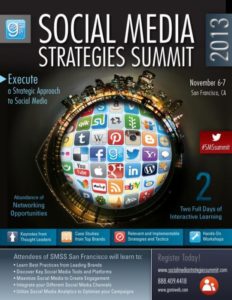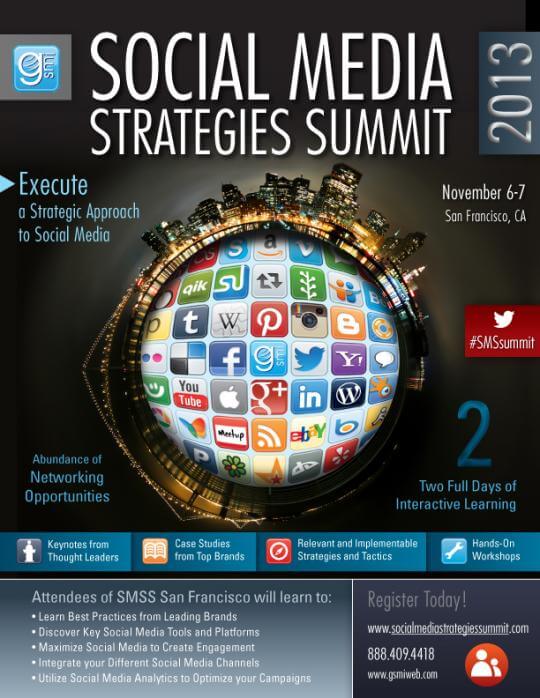It was somewhere between the Dungeons & Dragons analogies, the Mike Myers Shrek impressions, and the musical question period that I realized it: This was no typical social media conference. Social Media Strategies Summit, held last week in San Francisco, brought together a couple hundred industry professionals from some of the top brands, agencies and media, and technology vendors in the business to talk about everything social. And in the process, something funny happened: Unlike at many larger events, this small group of diverse people from all over the continent came together and forged a connection. Not an “engagement” as measured on a social media dashboard somewhere, but a human, authentic connection. It’s the sort of authenticity that marketers often talk about but rarely experience. And it served as a solid reminder that all we’re trying to do, when it comes to social media, is to connect to one another as human beings. 
“93% of word of mouth influence happens offline”
This staggering statistic was delivered by Mike Roberts of Convario during a pre-conference workshop on developing a social content strategy. Staggering, because we’re so accustomed to thinking of social media as something that takes place exclusively in the digital sphere. What we too often forget is that this conversation is seamless — across devices, across channels, but also on a continuing basis between the real and virtual worlds. What we see when we put something out there is only the tip of the iceberg in terms of a response. For every one person who likes, comments on or shares your content online, there are nine or ten more who are doing so offline. That means that the impact of your social media is probably nine or ten times bigger than you’ve been estimating. All the more reason why getting it right is so very important.
Redefining influence
Influence in social media remains a hot topic, as everyone from Hootsuite to Klout tried to define it differently. The industry has largely moved away from viewing an influencer as simply someone with a lot of followers or a large readership. The best definition came from Mike Roberts, who spoke of personal connections as the “long tail of influence”. Someone who is close to you and your customers, who is motivated to speak honestly about your products or services, and whose word means something to the people that matter, is going to be far more important as an influencer than a remote celebrity with a large Twitter following. Just as there is money to be made in the long tail of search marketing, the long tail of influence is a virtually untapped gold mine for marketers who can connect with the right content in the right place, at both a brand and a local level.
“Social is an approach, not a tactic”
During their day one closing keynote, Vincent Higgins and Tyler Wilson of DDB Worldwide said the above quote, which encapsulates how to think about social media. It’s not an add-on or something to be done by a department on the side, but it should be an integral part of everything you do, from SEM and Display Media to lead generation to UX to website development. Every interaction in the digital space is fundamentally social. It’s becoming more and more evident as the lines between different media types blur — ratings and reviews drive search results, Google is appending +1s to its search environment — but it has always been there.
If you’ve been viewing digital as one-way broadcast media, it’s time to shift focus. Michele Wingate of American Family Insurance agrees. During her presentation, she spoke of the importance of having a social media culture that is top-down in an organization. “Our CEO is active on Twitter, which sets the tone for everyone else”. In a highly regulated industry like insurance, Wingate stressed the importance of providing clear guidelines, lots of approved content, and success statistics in order to encourage employees to adopt social media channels.
Tools won’t replace humans anytime soon.
One thing that many people in the industry are experiencing as they attempt to expand their social media marketing efforts is a case of tool overload. There are some really fantastic social media tools and platforms out there, but it can be overwhelming to be presented with so many sales pitches and options. Katie Rohanna from Ziprealty addressed this in her presentation, stressing that all these tools fall broadly into three categories: Listening, Management and Measurement. Some do only one or two of the above well; some do all three. Many have plenty of bells and whistles (and hefty price tags to match), and it can be difficult to separate the marketing rhetoric from the useful facts and features. Rohanna spoke of the importance of identifying up front your organization’s needs and budget, and encouraged marketers to request plenty of demos and free trials when decided which tool is best for them. Ultimately, any tool is only as good as the person using it.
As much as we can find insights from data and metrics, they can only take us so far; it comes down to that human factor. The human factor was central to Cisco’s Leslie Lau’s opening keynote, all about how Cisco has found success by activating its employee base of 65,000 people to help promote its brand campaign. “The heart of marketing is always storytelling”, she said, which is a good reminder of what all the engagement metrics come down to. Higgins and Wilson agreed. They spoke of how they’ve game-ified the social UX planning process by using themes from geek culture — specifically Dungeons & Dragons — to build character personas. While this may not be for everyone, I think there’s a broader point here: Too often, we strip the fun out of social media. We’ve allowed engagement to become just another item on the to-do list, and we base so many of our decisions on data and metrics that we forget to inject the human factor. We can make social media fun again by thinking about audience members not simply as demographic or geographic stats but as real human beings.
Where is it all going?
There were plenty more great and informative talks over the two days, on subjects ranging from Pinterest, Klout, Twitter and Facebook, mobile and eCRM, running contests and promotions on social channels, using social media for customer service, and more. The big challenge continues to be proving ROI: Nearly everyone agrees that their social media efforts are yielding fruit, but there’s still no general industry consensus on how to prove it. But the key takeaways could be summed up by the Day Two closing keynote addresses. First, Tristan Bishop of Symantec spoke about using Twitter for customer service on an international scale, and he proved that engagement starts with making a real connection with his audience by agreeing to answer questions in the musical style of choice. Then, Travis Wright of Ensighten spoke of finding the “BRO” in social media — the “business relationship optimization — in a hilarious presentation that, between laughs, provided a long list of useful tips and tools for making your social media efforts all the more awesome.
Interested in finding out more? Contact us today!




